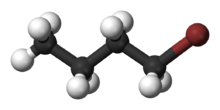- 1-Bromobutane
-
1-Bromobutane 
 1-BromobutaneOther namesButyl bromide
1-BromobutaneOther namesButyl bromideIdentifiers CAS number 109-65-9 
PubChem 8002 ChemSpider 7711 
ChEMBL CHEMBL160949 
Jmol-3D images Image 1 - BrCCCC
Properties Molecular formula C4H9Br Molar mass 137.02 g mol−1 Density 1.2686 g cm−3, liquid Melting point -112 °C, 161 K, -170 °F
Boiling point 101.4 °C, 375 K, 215 °F
Hazards MSDS Oxford MSDS  (verify) (what is:
(verify) (what is:  /
/ ?)
?)
Except where noted otherwise, data are given for materials in their standard state (at 25 °C, 100 kPa)Infobox references 1-Bromobutane (CH3(CH2)3Br) is a colorless liquid that is insoluble in water, but soluble in ethanol and diethyl ether. As a primary alkyl halide, it is especially prone to SN2 type reactions. It is commonly used as an alkylating agent, or in combination with magnesium metal in dry ether (Grignard reagent) to form carbon-carbon bonds.
1-Bromobutane may also be used to form organometallic compounds, such as n-butyllithium:[1]
- 2 Li + C4H9X → C4H9Li + LiX
- where X = Cl, Br
The lithium for this reaction contains 1-3% sodium. When bromobutane is the precursor, the product is a homogeneous solution, consisting of a mixed cluster containing both LiBr and LiBu. It can be formed by reaction of butanol with concentrated hydrobromic acid in presence of strong acid, such as sulphuric acid (H2SO4), by reaction of dibutyl ether with hydrobromic acid, or bromination of butane in presence of peroxide.
References
- ^ Brandsma, L.; Verkraijsse, H. D. (1987). Preparative Polar Organometallic Chemistry I. Berlin: Springer-Verlag. ISBN 3-540-16916-4.

This article about an organic halide is a stub. You can help Wikipedia by expanding it.
